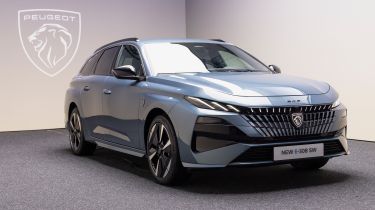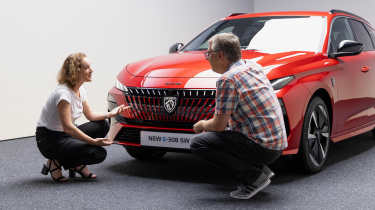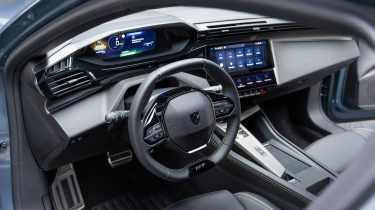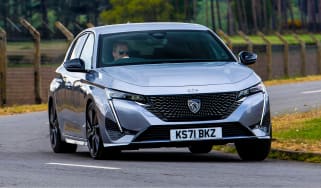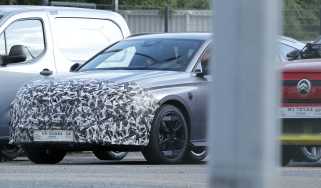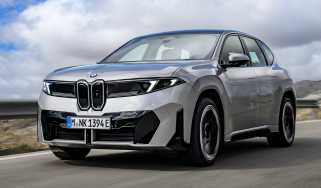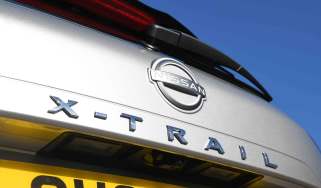New Peugeot 308 hits the UK: facelifted EV and hybrid options start under £30k
The 308 SW estate car is also available to order now, and like the hatchback it’s cheaper than before
The new Peugeot 308 is on sale now, with prices starting from £29,995 for the hybrid version and £29,495 for the electric E-308 thanks to the Government’s £1,500 Electric Car Grant (ECG). So the family hatchback is not only sharper-looking than before, it’s cheaper, too.
The same is true for the Peugeot 308 SW estate car, which has received the same sleek new look and sizable price cuts. The entry-level hybrid is available from £31,195, while the electric E-308 SW starts from £30,695 once the ECG has been taken into account.
Peugeot’s latest plug-in hybrid set-up is also available in both bodystyles, starting from £35,095 if you go for the 308, or £36,295 if you want the more practical 308 SW. A diesel version will be rejoining the line-up in spring 2026.
Compared to its Vauxhall Astra sister car, the new hybrid 308 costs about £1,500 more, although the new E-308 is available for roughly £3,000 less than the cheapest Astra Electric, even though the Vauxhall also qualifies for the ECG. However, you can currently get nearly £16,000 off a new (pre-reg) Astra Electric through our Buy A Car Service.
Meanwhile, the Volkswagen Golf starts from under £29,000, but the base version features a pure-petrol engine and a manual gearbox. To get a Golf with mild-hybrid power and an automatic transmission similar to the entry-level 308, you’ll need to pay closer to £32,000.
Specifications and technology
The new 308 and 308 SW are available in three trim levels: Allure, GT and GT Premium. Standard kit on all includes a 10-inch touchscreen with wireless Apple CarPlay and Android Auto, LED headlights with Peugeot’s signature three-claw design, a 180-degree reversing camera, adaptive cruise control and driver-attention warning. Hybrid models have 17-inch alloy wheels, while the EVs have 18-inch rims.
GT trim adds matrix LED headlights, an illuminated Peugeot shield badge for the front grille, leather-effect and cloth seats, ambient lighting, keyless entry, front parking sensors and 18-inch alloy wheels no matter what powertrain you go for.
Finally, the new GT Premium piles on a heated steering wheel, heated and massaging front seats, a 360-degree camera system, a 3D instrument display, Alcantara upholstery and additional driver-assistance tech including blind-spot detection and rear cross-traffic alert.
Range boost and upgraded brake regen system
The entry-level 308 features a 1.2-litre three-cylinder petrol engine while hybrid assistance is provided by an e-motor built into the car’s six-speed dual-clutch automatic transmission. This version produces 143bhp, is good for 0-62mph in 9.3 seconds and can return up to 62mpg.
The new 308 plug-in hybrid gets the 193bhp seven-speed auto set-up already found in the new 3008 and 5008 models, rather than the 222bhp system offered on the old 308. Performance is improved despite the cut in power, with 0.3 seconds shaved off the hatch’s 0-62mph time, dropping it to 7.6 seconds. More importantly, the electric range is increased by six miles to 53 miles from the 17.2kWh battery.
Peugeot is also still offering the 128bhp diesel engine despite the continued fall in demand for diesel cars. Insiders point to the model’s popularity with police fleets as the main reason for its retention in the line-up.
The electric versions now come with a 55.4kWh usable battery (up from 50.4kWh before), which has allowed Peugeot to bump up the range to 279 miles in the E-308, and 275 miles in the E-308 SW – an extra 25 miles for the hatchback and 20 miles for the estate.
For comparison, the most affordable Volkswagen ID.3 will do 241 miles on a charge, while top-spec models manage a claimed 371 miles on a charge. Unfortunately, there’s no change in the E-308’s rapid charging speed, which still sits at a pretty modest 100kW maximum; most rivals offer at least 120kW.
Peugeot has caught up with pretty much every electric car maker by finally offering adjustable brake regeneration on its EV, something that we’d expect to filter across the brand and its Stellantis-owned siblings, including Vauxhall and Citroen, as those electric cars are updated. Gone is the little ‘B’ button that switched the brake mode on or off, swapped for three levels of regen controlled by paddles behind the steering wheel.
Fresh look and interior upgrades
The most obvious change for the new 308 is the illuminated badge, with the French brand joining the likes of Vauxhall and Volkswagen by lighting up the company’s emblem on the top-spec 308 models for the first time. It forms part of a heavy revision of the 308’s front end.
The previous model’s gaping grille is toned down into a sharper and more aggressive look by adding a whole raft of body-coloured inserts. At the same time, the new ‘three-claw’ daytime running light signature replaces the vertical bar of the outgoing car, and on the top-spec GT and new GT Premium trims it gets short vertical lighting running the whole way across the bonnet to flank the illuminated logo.
The main headlamps are nestled away beneath the daytime running lights, and Peugeot has tried to make the car look wider via the sculpted bumpers and large air vent that helps efficiency by aiding air flow into the wheelarches.
“This is a generational change and with the new lighting signature moves the car into a more electrified era,” the 308’s design project manager, Michael Trouve, told Auto Express. “The headlamps hidden into the front face are almost invisible and give attention to the three-claw gaze area.”
The only major design change beyond the nose is that all cars now get the 3D three-claw rear lights previously only fitted to the top-spec GT, and there are also new blue colours for the hatch and SW estate models – Lagoa Blue and Ingaro Blue, respectively.
If you're tempted by the new-look Peugeot 308 or even the previous model, our Find a Car service has some fantastic offers on this stylish family car with top deals on brand-new Peugeot 308s as well as plenty of great value used Peugeot 308s. We can help you sell your car, too.
Cabin changes extend to new seat fabrics and updated graphics for the instrument cluster, while the new top-end GT Premium specification adds Alcantara heated massage seats, a 360-degree camera, plus the Driver Assist Plus safety pack and an alarm.
Now you can buy a car through our network of top dealers around the UK. Search for the latest deals…
Find a car with the experts

